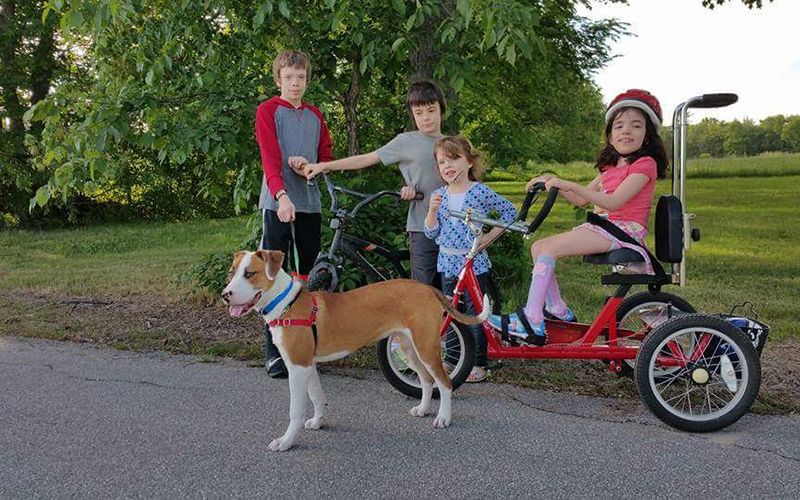Effects on gait by varying stiffness of ankle foot orthoses for children with cerebral palsy
Gait in children with Cerebral Palsy (CP) is often characterized by abnormal gait biomechanics, such as excessive knee flexion during stance. Associated with such gait deviations, an elevated walking energy cost is often observed, which may contribute to activity limitations. To treat these gait-related problems in CP, Ankle Foot Orthoses (AFOs) are commonly prescribed.

9 year old with cerebral palsy invents all-terrain walker. The real story behind Sadie McCallum’s amazing curb climber. Thriving – Boston Children’s Hospital
Yvette L. Kerkum, Annemieke I. Buizer, Josien C. van den Noort, Jules G. Becher, Jaap Harlaar, Merel-Anne Brehm, PLoS One November 23, 2015
When prescribing an AFO, the specific gait deviations and functional deficits of the patient should be clearly identified, such that these can be optimally addressed by the design and mechanical properties of the AFO. A rigid ventral shell AFO (vAFO) is typically used for children who walk with excessive knee flexion in stance; a gait pattern that is particularly energy consuming. Mechanically, a vAFO aims to shift the ground reaction force more anterior relative to the knee, which reduces the external flexion moment. This is expected to reduce knee flexion and decrease the elevated internal knee extensor moment during stance. Accordingly, this may reduce walking energy cost.
Although a vAFO may be effective in reducing knee flexion and subsequent walking energy cost, its high stiffness has the disadvantage of impeding ankle range of motion. Ankle range of motion during gait has been shown to be a key kinematic factor in gait efficiency. In fact, a reduced ankle range of motion during gait, especially towards plantar flexion, limits push-off power about the ankle, which almost always leads to an increased walking energy cost. Besides, a common strategy to compensate for reduced push-off power is to deliver work around the hip, which may also increase walking energy cost.
The metabolic penalty of limiting the ankle push-off power may be reduced by applying spring-like AFOs. These AFOs allow dorsiflexion in the beginning of stance phase, thereby storing energy within the AFO. This energy can be returned in pre-swing, which may support push-off power, therewith enhancing gait efficiency in terms of walking energy cost. Considering the key role of ankle range of motion during gait, an AFO that would additionally allow plantar flexion in late stance might support push-off power and gait efficiency even further.
The efficacy of spring-like AFOs to improve gait is however partly dependent on their stiffness. This has been shown in simulation models, as well as in studies in healthy adults and in adult patient populations, where results indicated that changing the AFO stiffness significantly affected knee and ankle kinematics and kinetics, as well as walking energy cost. Results also indicated that the reduction in walking energy cost could be improved by choosing the appropriate AFO stiffness. Such stiffness-based maximization of gait efficiency may also apply to children with CP, which is relevant considering that AFOs are not always effective in terms of reducing walking energy cost in these children, while this is an important goal of AFO prescription. However, the effects of different degrees of AFO stiffness on gait biomechanics and walking energy cost have not previously been reported in this patient group.
The aim of this study was to investigate the effects of varying vAFO stiffness on lower limb joint kinematics and kinetics and walking energy cost in children with spastic CP whose gait pattern is characterized by excessive knee flexion in stance. Stiffer vAFOs were expected to normalize knee flexion most effectively, though at the expense of obstructing ankle range of motion and push-off power. Contrarily, the less stiff vAFOs were expected to enhance push-off power, but to be less effective in counteracting knee flexion. We hypothesized that the optimal vAFO stiffness (i.e. at which walking energy cost would be lowest), would be defined by a trade-off between improving knee kinematics and kinetics, and enhancing ankle push-off power.
Source PLoS One
| References |
The Effects of Varying Ankle Foot Orthosis Stiffness on Gait in Children with Spastic Cerebral Palsy Who Walk with Excessive Knee Flexion, Kerkum YL, Buizer AI, van den Noort JC, Becher JG, Harlaar J, Brehm MA. PLoS One. 2015 Nov 23;10(11):e0142878. doi: 10.1371/journal.pone.0142878. eCollection 2015.
| Further reading |
The Role of Ankle–Foot Orthoses in Improving Gait in Children and Adolescents with Neuromotor Disability: A Systematic Review and Meta-Analysis, Faccioli, S., Tonini, G., Vinante, E., Ehsani, A., Pellarin, E., Cassanelli, G., Malvicini, F., Perazza, S., Venturelli, F., Guida, A., & Sassi, S. (2025). Prosthesis, 7(1), 13. https://doi.org/10.3390/prosthesis7010013
Effects of ankle-foot orthoses on different gait patterns in children with spastic cerebral palsy: A statistical parametric mapping study, Dobler F, Cip J, Lengnick H, Alexander N. Prosthet Orthot Int. 2023 Oct 1;47(5):449-456. doi: 10.1097/PXR.0000000000000216. Epub 2023 Feb 13.
Ankle foot orthoses in cerebral palsy: Effects of ankle stiffness on trunk kinematics, gait stability and energy cost of walking, Meyns P, Kerkum YL, Brehm MA, Becher JG, Buizer AI, Harlaar J. Eur J Paediatr Neurol. 2020 May;26:68-74. doi: 10.1016/j.ejpn.2020.02.009. Epub 2020 Feb 27. PMID: 32147412.
An individual approach for optimizing ankle-foot orthoses to improve mobility in children with spastic cerebral palsy walking with excessive knee flexion, Kerkum YL, Harlaar J, Buizer AI, van den Noort JC, Becher JG, Brehm MA. Gait Posture. 2016 May;46:104-11. doi: 10.1016/j.gaitpost.2016.03.001. Epub 2016 Mar 9.
Acclimatization of the gait pattern to wearing an ankle-foot orthosis in children with spastic cerebral palsy, Kerkum YL, Brehm MA, van Hutten K, van den Noort JC, Harlaar J, Becher JG, Buizer AI. Clin Biomech (Bristol, Avon). 2015 Jul;30(6):617-22. doi: 10.1016/j.clinbiomech.2015.03.023. Epub 2015 Mar 28. PMID: 25854606.
Optimising Ankle Foot Orthoses for children with cerebral palsy walking with excessive knee flexion to improve their mobility and participation; protocol of the AFO-CP study, Kerkum YL, Harlaar J, Buizer AI, van den Noort JC, Becher JG, Brehm MA. BMC Pediatr. 2013 Feb 1;13:17. doi: 10.1186/1471-2431-13-17.
